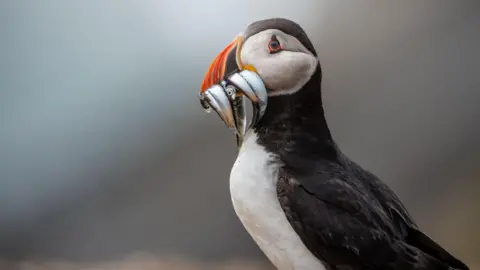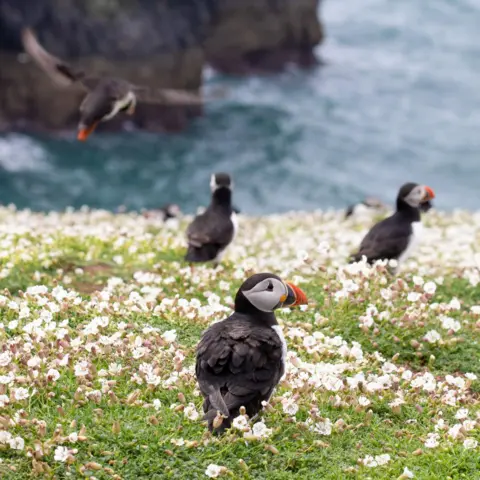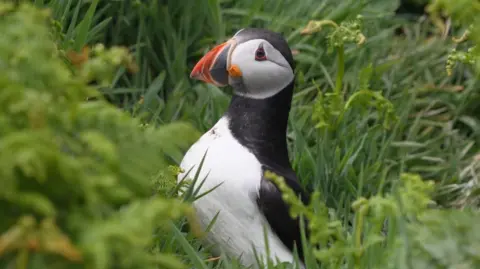Elen Davies
BBC News
Reporting fromSkomer Island

 Amy Compton
Amy Compton
Conservationists have counted 43,626 puffins on Skomer Island this year - a new record
A record number of puffins have been recorded on a small island off the Pembrokeshire coast, despite global populations declining rapidly.
According to the Wildlife Trust of South and West Wales (WTSWW), 43,626 puffins were counted on Skomer Island this year - a record high.
The WTSWW said the increased number of puffins on the nature reserve was a "conservation success story", but warned that the birds were still a species under threat which should continue to be protected.
Skomer Island, a 2.92km² internationally important seabird island managed by the WTSWW, is located less than a mile from the Pembrokeshire coast.
The island's isolation means that it is protected from predators such as rats, cats, dogs and foxes, and also from the human impact on the mainland.
As well as a growing population of puffins, Skomer is also home to 350,000 breeding pairs of manx shearwaters and thousands of guillemots and razorbills.
Every year, the WTSWW undertakes its annual seabird count on the island to monitor the population of birds that return every spring to breed.
The puffins are counted during the evening and early in the season by six members of staff.

 Grace Hunt
Grace Hunt
Skomer Island, famous for its seabird populations, attracts around 25,000 visitors each year
Skomer Island's visitor officer, Rob Knott, said counting the birds was "quite a job".
"We split the island into sections and we go round about two hours before sunset when there's the most on the land," he said.
"We get our clickers out and we count all the ones on the land, then the sea and the ones in the air as well."
The last record was set in 2023, when 42,513 puffins were recorded on and around the island.


Conservationists believe puffins are thriving on Skomer due to the abundance of food and lack of predators
"We think [the counting accuracy] is probably within a few hundred or perhaps a thousand birds," said Rob.
"Of course, that number is not going to be dead on the right number of puffins that are here, but because we do it in the same way every year and record those birds in the same way, it's always been reported as the final number of that count that we do every year."


Rob Knott says counting the puffins on Skomer Island is "quite a job"
Although the puffins seem to be thriving in Pembrokeshire, there is a rapid decline elsewhere.
Like many seabird species, puffins are listed as vulnerable to extinction on the global International Union for Conservation of Nature (IUCN) red list, as they face pollution, food shortages and climate change.
According to the WTSWW, the growth in Skomer Island's puffin population is "likely linked to the abundance of food in the wider area, meaning there is plenty of fish for chicks resulting in high breeding success".
They said the absence of rats and other predators on the island had also contributed to the seabirds' success.


Puffins are listed as vulnerable to extinction on the global IUCN Red List
'Cautiously optimistic'
Rob said the island's 25,000 visitors each year were often "mind-blown" by the number of puffins.
He warned, however, that there were novel threats facing seabirds - including bird flu and the recent marine heatwave conditions experienced around parts of the UK coastline.
"I think the monitoring work is absolutely vital, it informs how these seabirds are doing, particularly in this part of Wales but also on a wider scale in terms of how puffin numbers are doing throughout the UK," he said.
"It helps us look towards policy on how these numbers can increase in the future.
"They're doing well here, but we can point to this as a good example, there's other places where these numbers are really going down quite rapidly.
"We're quite cautiously optimistic about the numbers that we're seeing.
"They're absolutely iconic birds and the fact that they're on the red list is wrong for so many reasons, not least, because they used to be absolutely thriving, so we're doing what we can to try and improve those numbers."

 Movie
Movie 2 months ago
174
2 months ago
174 






![Presidents Day Weekend Car Sales [2021 Edition] Presidents Day Weekend Car Sales [2021 Edition]](https://www.findthebestcarprice.com/wp-content/uploads/Presidents-Day-Weekend-car-sales.jpg)



 English (United States)
English (United States)